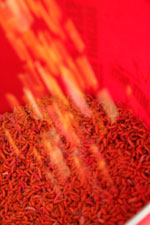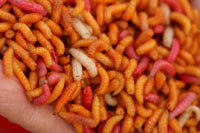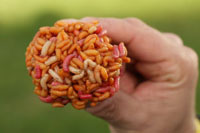Sticky Situation
When groundbaits are not an option and blockend feeders are too slow to distribute bait quickly there is another way, sticky maggots!
There are times when fishing with maggot hook baits on a commercial venue that you need to get a large quantity of feed down on the deck quickly to keep feeding fish tight in an area.
That’s not a problem when groundbait is allowed, but what do you do when it’s use is banned?
You could use blockend feeder tactics, but the problem with that is the bait tends to disperse from the feeder too slowly and you end up with fish attacking it rather than grubbing around on the deck and finding your hook bait.
A better option for getting the bait out onto the bottom is an open-end feeder, but how do you get the active bait to stay in until it reaches its destination? The answer is to use sticky maggots, or ‘stickymag’ as anglers call it.
This is a great way to fish maggots at distance, as the bait stays onboard until the feeder hits the deck and when it does land, moments later the feed explodes out and creates an active bed of freebies. And because the feed disperses quickly you can retrieve and recast with the knowledge that all the bait is out and you’re not leaving a trail of stragglers in the feeder’s wake, as is sometimes the case with blockends.
Sticky maggots are primarily used on commercial venues, but on fast, shallow river glides it’s a good way of getting a large portion of maggots to the bed quickly, so that a compact trail of freebies is carried downstream to attract species such as chub and barbel. You can add gravel to get the bait down quickly.
The added bonus of the maggots being sticky is you are able, if you get the stickyness right, to pack a lot into any size feeder, confident in the knowledge that they will not fall out when you cast.
There are a number of recipes for creating sticky maggots using concoctions from bait manufactures to everyday products like Horlicks. The best purpose-made ‘stickymag’ we’ve come across is made by Colmic.
The following sequence is the tcf team’s way of preparing them – you will need at least four pints of maggots.
 |
Step 1
The first job is to riddle the bait of and maize or sawdust. |
|
 |
Step 2
Once cleaned, store the maggots in a clean, dry bucket. |
|
 |
Step 3
Although cleaned the bait still has a covering of dust… |
|
 |
Step 4
… so wet your hand a run it through the bait to remove it. |
|
 |
Step 5
You’ll be surprised at how much dust you get on your hand. |
|
 |
Step 6
Repeat the process a few times until the maggots look shiny. |
|
 |
Step 7
Now add some of the sticky maggot powder to the bait – not too much. |
|
 |
Step 8
Using a dry hand, work the powder in to get the bait well coated. |
|
 |
Step 9
You need to take a view now as to whether you need to add some more powder |
|
 |
Step 10
Leave for about 15 minutes. When ready you should easily be able to form balls of maggots. |
|
 |
Step 11
Before loading the feeder, dip it in maize like this. |
|
 |
Step 12
This will coat the sides and stop water in the feeder breaking up the balls. |
|



















